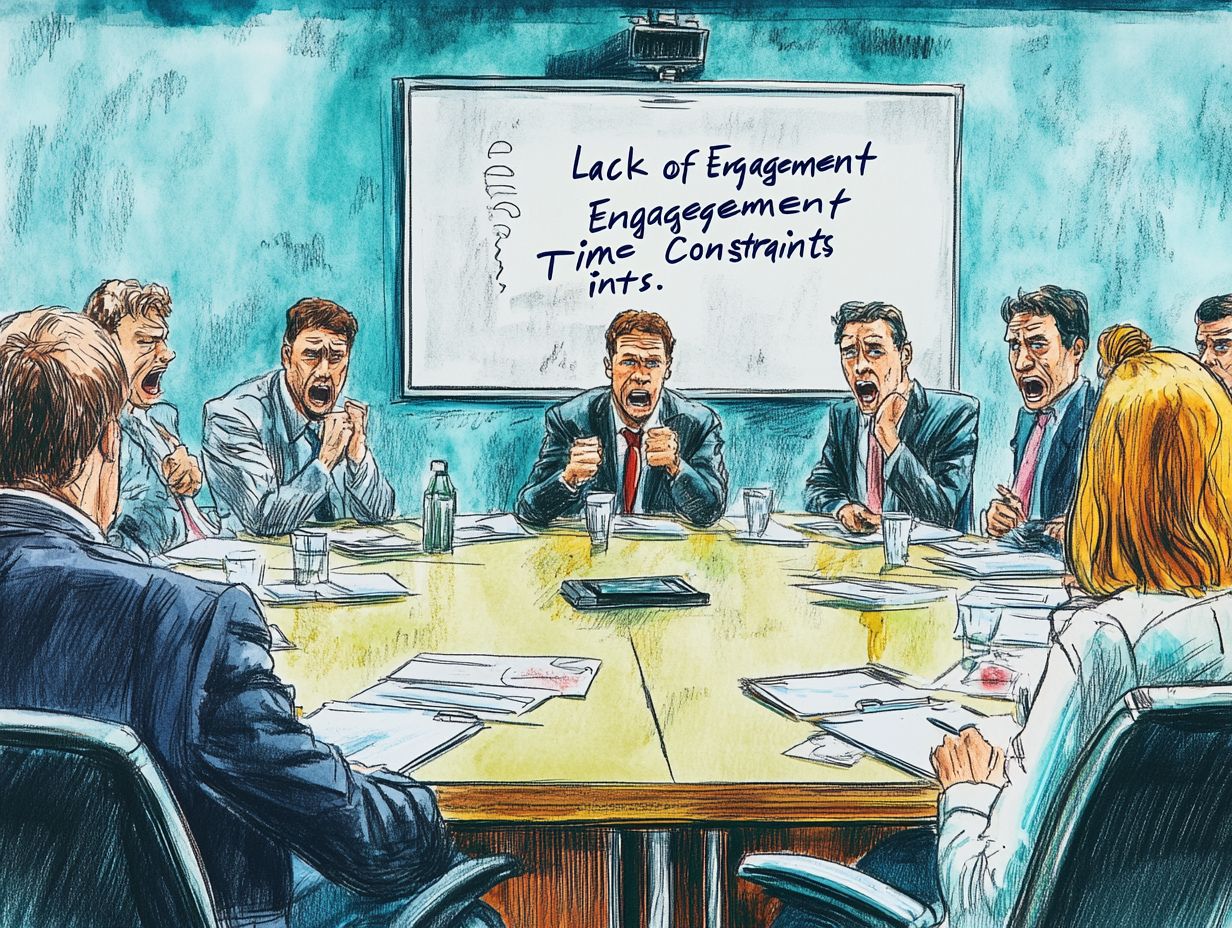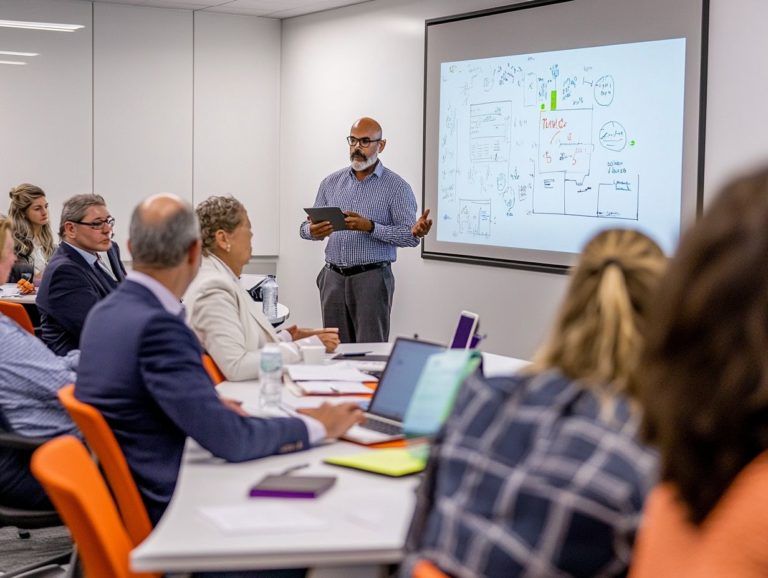What Are the Common Challenges in Corporate Training?
In today’s fast-paced business landscape, effective corporate training is vital for nurturing employee growth and driving organizational success. You may encounter significant challenges that impede the training process, such as lack of engagement, time constraints, and difficulties in measuring effectiveness. Let s explore these common challenges and discover exciting solutions like leveraging technology and fostering collaboration to boost training effectiveness.
You will discover best practices designed to cultivate a positive learning environment that encourages continuous improvement. Prepare to elevate your corporate training approach to new heights!
Contents
- Key Takeaways:
- Top Challenges in Corporate Training
- Solutions to Overcome Corporate Training Challenges
- Best Practices for Successful Corporate Training
- Frequently Asked Questions
- What Are the Common Challenges in Corporate Training?
- What Are the Challenges in Designing a Corporate Training Program?
- How Do You Measure the Effectiveness of a Corporate Training Program?
- What Are the Most Common Obstacles to Employee Engagement in Corporate Training?
- What are the challenges in using a mix of in-person and online training in corporate training?
- How can companies overcome these challenges?
Key Takeaways:

- Engagement is a common challenge in corporate training. Employees may struggle to stay motivated and interested. Solutions include using interactive methods, such as game-like elements in training to make it more fun.
- Time and resource constraints can hinder training success. Companies should utilize technology and collaborate with employees to create flexible and efficient training programs.
- Measuring the effectiveness of corporate training is crucial for ensuring a return on investment. Best practices include setting clear goals, using data to track progress, and soliciting feedback from employees.
What is Corporate Training?
Corporate training systematically enhances your employees skills and knowledge. This process aims to improve overall business performance and achieve strategic leadership goals. This multifaceted approach targets skill gaps, ensuring your team is well-equipped with both hard and soft skills essential for their specific roles.
By implementing effective learning programs and leveraging modern learning technologies, you can cultivate a culture of continuous learning. This boosts employee productivity and propels organizational growth, enhancing employee retention.
A critical aspect of corporate training is conducting a thorough training needs assessment. This allows you to pinpoint areas that require attention and tailor your training materials accordingly. The importance of personalized training cannot be overstated, as it provides a customized learning experience that caters to individual needs.
Blended learning, a mix of in-person and online training methods, further elevates training effectiveness. It makes learning more accessible and engaging for your employees. Ultimately, a well-structured corporate training program equips your staff with vital competencies and aligns their development with the strategic objectives of your organization.
Top Challenges in Corporate Training
Organizations frequently face a myriad of training challenges that can obstruct successful corporate training initiatives. Understanding what makes a successful corporate training program can help address these challenges, ultimately impacting employee productivity and overall business performance. Common obstacles include a lack of engagement from employees, difficulties in measuring the effectiveness of training programs, and existing knowledge gaps that hinder learning outcomes.
To overcome these hurdles, you must conduct a thorough training assessment. This helps identify these issues and develop effective training solutions that align seamlessly with your organization s strategic goals. Addressing these challenges is vital for your team s success and your company s growth.
Lack of Engagement
A major barrier to effective corporate training is the lack of employee engagement. Understanding the future of corporate training can help address these issues, as it often leads to poor training effectiveness and knowledge gaps.
When employees aren t involved, they miss out on developing essential soft skills like emotional intelligence and effective communication.
Encouraging interactive training and gamification can create a more engaging learning environment.
Innovative methods can change how we learn. Imagine using virtual reality simulations that place you in realistic scenarios.
These encourage critical thinking and decision-making. Interactive sessions like discussions and role-playing promote participation and reinforce concepts.
Gamification techniques such as point systems and reward challenges boost engagement.
For example, a global tech firm increased training retention by 40% with gamified modules. This inspires a culture of continuous learning.
Time and Resource Constraints
Time and resource limitations challenge corporate training programs. Organizations often struggle to find time for training amidst busy schedules, which raises questions about the costs associated with corporate training.
This can hurt productivity and prevent addressing skill gaps.
To solve these issues, leverage eLearning platforms and microlearning. These provide flexible, on-demand training solutions.
Platforms like Coursera for Business allow for custom content tailored to job roles. This ensures relevance and boosts retention rates.
Microlearning delivers targeted knowledge in a few minutes, letting employees learn at their own pace.
For instance, bite-sized video tutorials can train staff on new software updates quickly. This minimizes disruption and allows immediate application of skills.
These strategies create a more agile learning environment that supports individual growth and organizational objectives.
Measuring Effectiveness

Measuring training effectiveness is vital for aligning solutions with organizational needs. This fosters a culture of continuous learning.
Without a solid assessment framework, evaluating ROI and identifying areas for improvement can be difficult.
Utilizing employee feedback and training assessments provides insights into program strengths and weaknesses. This helps adapt strategies for better learning outcomes.
Consider these assessment methods:
- Pre-and post-training evaluations
- On-the-job performance metrics
- Follow-up surveys
Engaging employees in feedback promotes open communication. It empowers them in their own development paths.
By analyzing feedback, uncover patterns that show which training elements work best and which need improvement.
These insights help shape future training strategies, creating an environment of continuous improvement and innovation that aligns with your business goals.
Solutions to Overcome Corporate Training Challenges
To successfully navigate the challenges in corporate training, embrace a variety of innovative solutions that harness technology and encourage collaboration among your employees.
Implementing blended learning approaches that combine online resources with hands-on experiences cultivates a more adaptable learning environment tailored to your workforce’s diverse needs.
Integrating virtual coaching while nurturing a culture of feedback can significantly elevate the training process. This results in heightened employee engagement and enhanced skill development.
Innovative Training Methods
Adopting innovative training methods is essential to enhance employee engagement and tackle various training challenges within your organization.
Leveraging these strategies accommodates the diverse learning needs of your workforce and boosts overall productivity. For example, implementing virtual reality (VR) simulations provides immersive experiences that offer practical, hands-on training in a secure environment.
This approach not only builds confidence but also significantly improves skill retention.
Technology plays a pivotal role in providing seamless access to training resources, allowing employees to engage in self-paced learning whenever it suits them.
As organizations embrace data analysis, you can evaluate the effectiveness of your training programs and make data-driven adjustments. This further optimizes the learning experience for everyone involved.
Utilizing Technology
The use of technology in corporate training has transformed the learning landscape, providing tools that enhance both effectiveness and accessibility.
With eLearning platforms, you can engage with training materials at your own pace, while advanced learning technologies allow for a personalized training experience that addresses your unique skill gaps.
Virtual coaching and data-driven training enable your organization to monitor progress closely and adapt strategies based on real-time analytics. This ensures a targeted approach to professional development.
These advancements boost engagement and create a more inclusive environment for learners from diverse backgrounds.
You will see improved retention rates as you interact with dynamic multimedia content that caters to various learning styles. Asynchronous learning options eliminate logistical hurdles, making it easy for teams across different time zones to participate.
Incorporating gamification elements can further elevate motivation and participation, transforming training sessions into enjoyable experiences.
By harnessing these technologies, your company can cultivate a more skilled workforce prepared to tackle the evolving demands of the industry!
Collaboration and Feedback
Fostering a culture of collaboration and feedback is essential for enhancing employee engagement and elevating the effectiveness of your corporate training initiatives.
Encouraging employees to collaborate regularly, share insights, and provide feedback on their training experiences creates a dynamic learning environment that promotes continuous growth and development.
Integrating regular team-building exercises and leveraging collaborative digital tools enable your teams to work together more effectively.
For example, implementing a mentorship program allows seasoned employees to share their wisdom with newcomers, cultivating a feedback-rich atmosphere.
Incorporating anonymous surveys can yield honest input on training sessions, ensuring that every voice is heard and valued.
These strategies enhance the overall training experience and foster a sense of belonging among your employees. This ultimately drives productivity and innovation throughout your organization.
Don’t miss out on this opportunity to implement these effective strategies in your corporate training programs!
Best Practices for Successful Corporate Training

Implementing best practices in corporate training is crucial for maximizing the effectiveness of training programs and ensuring alignment with your organizational goals. Cultivating a positive learning environment promotes engagement and collaboration, significantly enhancing employee retention and fostering professional development.
A mindset of continuous improvement allows you to respond effectively to evolving workforce needs and new training technologies, ultimately driving successful training outcomes.
Creating a Positive Learning Environment
A positive learning environment is essential for enhancing employee engagement and ensuring the success of corporate training programs. When a supportive atmosphere encourages open communication and collaboration, employees feel comfortable sharing their thoughts and experiences, enriching their learning journey.
Incorporating hands-on training opportunities and emphasizing emotional intelligence helps cultivate a learning culture where employees thrive personally and professionally.
Strategies like mentorship programs and team-building exercises deepen connections among staff. For instance, pairing seasoned employees with newcomers creates a nurturing environment where knowledge flows freely and skills are sharpened. Integrating feedback mechanisms allows individuals to voice their needs and interests, aligning training with real-world applications.
Look to companies like Google and Zappos as examples of best practices. They prioritize employee well-being and engagement, resulting in a motivated workforce eager to learn and grow. Such initiatives enhance team dynamics and drive overall organizational success.
Continuous Improvement and Adaptability
Continuous improvement and adaptability are crucial for successful corporate training. They allow you to remain responsive to the ever-evolving needs of employees and the shifting market demands.
Embracing these principles ensures that training initiatives are relevant and impactful. To implement this effectively, consider these actionable steps:
- Establish regular feedback loops for employees to share their training experiences.
- Utilize analytics to track progress.
- Align programs with both personal and organizational goals.
Making decisions based on data enables you to refine training methods based on measurable results and insights. Moreover, incorporating employee feedback into training design fosters an inclusive environment, promoting a sense of ownership among team members.
By prioritizing these practices, you will be better equipped to thrive in a competitive landscape.
Frequently Asked Questions
What Are the Common Challenges in Corporate Training?
Common challenges in corporate training include:
What Are the Challenges in Designing a Corporate Training Program?

Designing a corporate training program can be complex. Challenges companies may face include:
How Do You Measure the Effectiveness of a Corporate Training Program?
Measuring the effectiveness of a corporate training program can be challenging but is essential for ensuring program success. Common methods for measuring effectiveness include:
What Are the Most Common Obstacles to Employee Engagement in Corporate Training?
Employee engagement is crucial for the success of any corporate training program. However, understanding the types of corporate training programs can help overcome obstacles that may hinder employee engagement, including:
What are the challenges in using a mix of in-person and online training in corporate training?
Blended learning combines traditional classroom training with online learning. This means combining face-to-face instruction with online courses. While it can bring many benefits, companies may face some challenges.
How can companies overcome these challenges?
With careful planning, companies can tackle these challenges effectively. Don’t let these challenges hold you back act now! Here are some strategies to ensure the success of their training programs:






